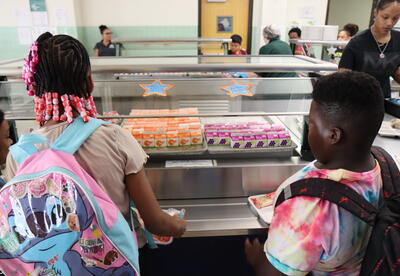
Welcome to the Ready Room at Edmund J. O’Neal Middle School of Excellence, an inviting and tranquil place where students who struggle with their behavior can come to take a breath and reset themselves.
The space formerly known as room 219 was the school’s in-school suspension room. Now it’s a haven of sorts for students who have experienced life trauma that affects their ability to succeed in school.
Data shows that more than half of all U.S. children have experienced some kind of trauma in the form of abuse, neglect, violence, or challenging household circumstances, and 35 percent of children have experienced more than one type of traumatic event, according to the Centers for Disease Control and Prevention (CDC).
The Ready Room is an example of the City School District of 91ΗΘάϊΒΦΚΫ’s change in its approach to troubled kids. Rather than punish students whose response to trauma is to act up, “trauma-informed” teachers, counselors and others are trained to recognize and respond to trauma-stressed students and guide them through challenging situations.
“Trauma-informed care is a completely opposite approach to the use of traditional in-school suspension rooms,” said Victoria Martell, a behavior specialist at O’Neal and the person who transformed the former detention room into a trauma-informed space. (She is pictured in one of the room's calming spaces.)
Trauma-informed care helps students learn the tools to cope with extreme situations. It also gives them a sense of their own safety. Students feel understood and supported, which leads to them feeling empowered and better able to regulate their bodies and emotions, Martell said.
O’Neal is piloting the program for the last six weeks of school. It serves 10 students who visit the room once or twice at a scheduled time each day.
Being trauma-informed takes a shift in mindset, said Brianna Olsen, a trauma-informed trainer for the school district’s Office of Pupil Personnel Services.
“The shift from ‘what is wrong with you’ to ‘what happened to you’ is critical,” Olsen said. “Trainings help staff understand how trauma affects brain development and how students with trauma may present in their educational setting,”
So how do you determine which behavior is a result of trauma and which is a result of bad choices?
“There really isn’t a way to determine if challenging behaviors are impacted by trauma exposure since we don’t always have that information, so we cautiously approach all students with trauma-informed practices,” Olsen said.
Every school in the district has at least one person certified in trauma-informed practices who also can train other staff members. The district has devoted additional trauma-informed resources to O’Neal, Schuyler Achievement Academy and Tony Clement Center for Education, as well.
In the meantime, Victoria Martell’s Ready Room is ready for the 10 struggling students. Starting in September, it will be open to all.
The mission of the City School District of 91ΗΘάϊΒΦΚΫ is to educate and prepare all students for college and career, citizenship and life, in partnership with our diverse community. The district serves approximately 9,300 students in 18 elementary, middle and high schools. In addition to neighborhood schools, the district includes several magnet schools and programs, as well as other innovative academic opportunities for students, including four themed academies at 91ΗΘάϊΒΦΚΫ High School.




